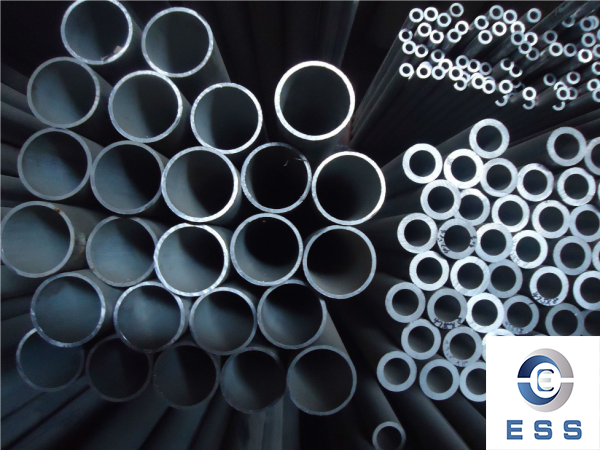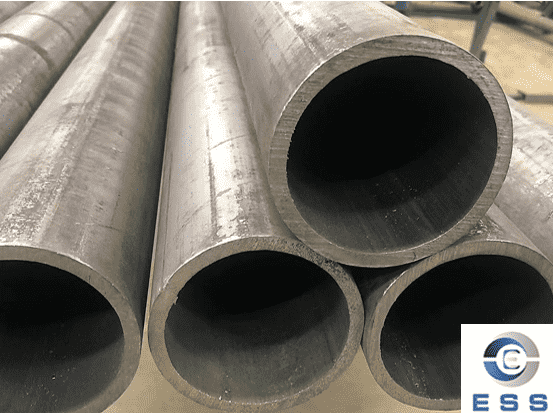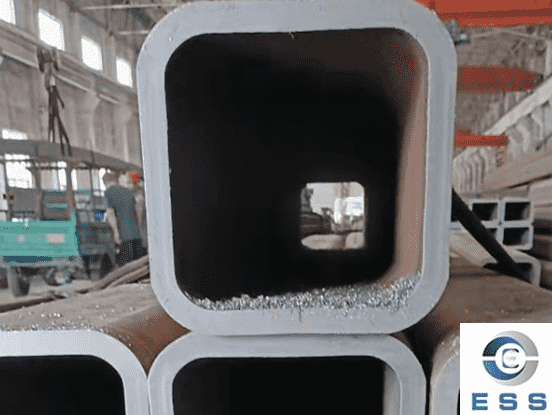Tensile strength of stainless steel seamless pipes
There are many factors that affect the drawing force during the drawing process of stainless steel seamless pipes. According to research, some of these factors are beneficial to the drawing process. Conversely, other factors can make stretching more difficult. Drawing process and properties of drawn metal, heat treatment, deformation per pass and drawing speed. The friction, lubrication, geometric dimensions and mold shape between the waste pipe and the mold are closely related.

1. Waste pipes
Different chemical compositions and organizational structures have different mechanical properties, which directly affect the tensile force. For example, the tensile strength of No. 20 carbon steel and 36Mn2Si scrap pipe must be much greater than that of No. 120 steel. The reason is mainly due to the different mechanical properties and insulation properties of the two materials.
The tube blank produces work hardening during the drawing process, which increases the deformation resistance and reduces the plasticity. If you continue to pull, the pulling force will continue to increase, which will increase the internal stress of the tube blank and easily cause cracks or crack defects. Insensitive to rough pipes with uneven wall thickness. In order to eliminate the internal stress of the drawn waste pipe, annealing should be carried out in time.
2. Draw the mold shape
Mainly the shape of the outer mold for drawing (i.e. the width of the working belt and the size of the drawing angle). The influence of working belt width on tensile force increases with the decrease of tube blank deformation. Because when the deformation is small, the waste pipe enters the work area mainly under the compressive stress state of forced deformation, and external friction is generated between the waste pipe and the work belt, increasing the tensile force. If the pulling angle is too large, the bending deformation of the waste pipe will increase, the deformation stress will increase accordingly, and the pulling force will increase. Moreover, the pulling angle is too large, the lubrication conditions deteriorate, the friction coefficient increases, and the pulling force also increases. If the difference angle is too small, under the same deformation conditions, when the specific angle is larger, the contact area increases, the friction force increases, and therefore the pulling force increases. Therefore, the reasonable design of the air outlet angle is a very important factor. Generally speaking, an angle of 12-13° is more suitable.
The surface finish and hardness of the drawing mold have a very obvious impact on the drawing force. The mold should have sufficient hardness and good surface finish, which will reduce friction between contact surfaces and reduce pulling force. On the contrary, inferior molds do not have sufficient hardness and surface finish, which will inevitably lead to increased friction. Promote the increase of pulling force. Therefore, the preparation of molds is a very important task, and using high-quality molds is one of the main conditions for obtaining high-quality steel pipes.
3. Preparations for waste disposal before evacuation
The quality of pickling, washing, lubrication and other processes is extremely important. It is directly related to the friction during stretching. A good preparation process can greatly reduce the friction of shooting. Correspondingly, the pulling force decreases. This creates favorable conditions for increasing the amount of tensile deformation.
The effect of pulling speed on pulling force is not obvious, which has been proven by research and practical experience. When the drawing speed increases, the pulling force during the drawing process increases slightly, about 4-8%. The differential speed continues to increase, and the pulling force does not change much, but increases slightly, and the increase is relatively gentle. This fully shows that it has nothing to do with the drawing speed, and can completely increase the drawing speed and increase the output.
To sum up, there are many factors that affect pulling force. Due to different operating methods during the production process, the pulling force of the wastewater pipe may be completely different. In order to improve the drawing conditions and reduce the drawing force, the selection of raw materials (that is, the waste pipe should have excellent material and good mechanical properties, etc.). Reasonable preparation work (such as pickling, rinsing, lubrication, heat treatment and other process quality), distribution of deformation and determination of drawing passes are all necessary conditions for the production of high-quality steel pipes.
The production of high-quality steel pipes also requires some heat treatment. Next, we will introduce one of them.
Stainless steel seamless pipe bright heat treatment
The so-called bright heat treatment includes bright annealing, bright normalizing, bright quenching and bright tempering. In order to prevent the surface of stainless steel seamless pipes from oxidation and decarburization so that they do not lose their metallic luster, heat treatment should be carried out in a protective atmosphere or vacuum as mentioned above.
Bright heat treatment process principle
1. Solid solution treatment: Stainless steel is a special steel containing a variety of alloy elements. After cold working, the original uniform austenite structure is destroyed and the hardenability is obvious. In order to restore the original grain structure, the cold-worked austenitic stainless steel seamless pipe is heated to the high-temperature single-phase zone and maintained at a constant temperature to dissolve various alloy components including impurities into each other. At the same time, during the cold working process, a large number of dislocation-deformed metal grains begin to expand, and eventually uniform grains are precipitated from the stable solid solution through rapid cooling, and return to the austenite structure.
2. Bright treatment. During the heating and insulation process of stainless steel seamless pipes, if air enters the surface, black oxide scale will appear. In order to ensure the brightness of the substrate, nitrogen and hydrogen gas decomposed by ammonia are passed through the heat treatment furnace tube or furnace as a protective atmosphere. Nitrogen is a neutral gas that can protect the workpiece from oxidation and decarburization at high temperatures and keep it bright. Hydrogen can not only protect the brightness, but also has a strong reducing effect, making the workpiece brighter and silvery white, and improving the smoothness of the base material. .
Common defects in bright heat treatment of stainless steel seamless pipes
1. Insufficient hardness
2. High hardness
3. There are black spots on the surface of the steel pipe, which is not beautiful.
4. The surface of the steel pipe is silvery white with rust.
5. The first batch of steel pipes had poor brightness
6. Black frost or white frost appears in batches
Strict quality control is also required during the production process of high-quality steel pipes to avoid all factors that cause unqualified steel pipes.
Quality control of stainless steel seamless pipes
Stainless steel seamless pipes are widely used in pipeline systems in high-pressure, low-temperature and corrosion-resistant environments. Mechanical properties, process properties and corrosion resistance are three important indicators to measure the quality of steel pipes, and are also an important guarantee for safe navigation of ships. So how to avoid surface quality problems?
1. Control the quality of raw materials
The raw materials used in the production of
seamless steel pipes are mainly continuous cast round tube billets and rolled (forged) round steel. Ensuring the quality of steel billets is the first step to ensure the quality of steel pipes, which mainly includes steelmaking level, pouring and cooling process, forming quality, etc. One is to improve the level of steelmaking. It is necessary to reduce harmful elements and gases (nitrogen, hydrogen, oxygen), improve the uniformity and purity of ingredients, reduce non-metallic inclusions, and change their distribution form. When the composition of the steel billet is uneven and severe segregation occurs, the rolled steel pipe will show a severe banded structure, thereby reducing the mechanical properties and corrosion performance of the steel pipe, or even failing. Non-metallic inclusions (such as sulfides and oxides, silicates) are pressed into thin sheets, which not only affects the performance of the steel pipe, but may also cause cracks in the steel pipe during the production process. In addition, shape deviations such as straightness, diameter, and ovality of the tube blank will also directly affect the perforation quality and cause quality defects of the waste tube.
2. Ensure the accuracy and uniformity of furnace temperature control
Furnaces used to manufacture seamless steel pipes include billet heating furnaces and steel pipe heat treatment furnaces. Temperature control accuracy and uniformity are two important indicators for judging the quality of heating equipment, and are also an important guarantee for the heating process. Therefore, manufacturers should strictly implement the regulations on thermocouple service life and calibration intervals as well as furnace temperature uniformity testing.
The formulation of the heating process should comprehensively consider the inherent performance of the furnace equipment, the type and quantity of tube blanks or steel pipes, and strictly control the heating rate, holding time and cooling rate to avoid cracks, overheating or overburning.
3. Optimize inspection processes and equipment
The inspection of intermediate products during the manufacturing process of stainless steel seamless steel pipes is the key to controlling the quality of finished pipes, especially the quality of the inner wall surface, which must be done from the source. First, we must establish reasonable and effective inspection and handling procedures to ensure that existing problems can be discovered and effectively handled. Secondly, sufficient and effective testing equipment is also needed. Such as endoscopes, thickness gauges, flashlights, etc., which can quickly identify the type and location of defects.
Stainless steel round billets are made into seamless steel pipes through major processes such as perforation, cold drawing/cold rolling, solid solution, straightening, and pickling. All aspects of pipe making complement each other, especially the quality control of raw materials and intermediate products, which is an important guarantee to ensure that the chemical composition, surface quality, mechanical properties, process performance and corrosion resistance of finished pipes meet national standards.
Finally, how to choose the one that suits you among the many steel pipes? Next, I will introduce you to the selection method.
How to choose the right stainless steel seamless pipe?
Stainless steel seamless pipes are widely used in petrochemical, electric power, energy, aerospace and other fields due to their corrosion resistance, high temperature resistance, high pressure resistance and other properties. However, different application scenarios require different stainless steel materials, so how can we choose the appropriate stainless steel seamless pipe material?
1. Corrosion resistance
The corrosion resistance of stainless steel is one of its most important properties. Different application scenarios have different corrosive media, such as acid, alkali, hydrochloric acid, etc. Therefore, stainless steel materials with corresponding corrosion resistance need to be selected. For example, stainless steel 304/304L, 316/316L, etc. are used in situations with low corrosion resistance, while 904L, 254SMO, etc. are suitable for situations with high corrosion resistance requirements.
2. Strength and toughness
Different application scenarios have different strength and toughness requirements. For example, equipment working in high temperature and high pressure environments needs to have high strength and toughness. The pipelines used in pharmaceutical, food, cosmetics and other industries have higher hygiene standards, and stainless steel 304, 316 and other materials are usually used as pipeline materials.
3. Processing performance
The processing performance of stainless steel seamless pipes is also an important consideration. In some complex process links, materials with higher performance need to be used, such as stainless steel with particularly good hardness and toughness, such as 17-4PH stainless steel. However, due to poor processing performance, this stainless steel is usually suitable for production fields with higher processing technology requirements.
4. Density and cost
Density and cost are also factors to consider when selecting stainless steel seamless pipe materials. There is not much difference in the density of different types of stainless steel. Generally speaking, choosing lower density stainless steel can reduce the weight of the equipment while saving costs.
Things to note when choosing stainless steel seamless pipes:
1. When purchasing, you should choose high-quality products that have been identified by the Quality and Technical Supervision Bureau. Having long-term testimonials and good customer reputation is the most direct and effective way to purchase.
2. Check whether the outer surface and inner wall of the pipe are bright and smooth, and whether the thickness is uniform or rough. Generally, stainless steel welded pipes basically do not require inspection, while stainless steel seamless pipes are produced by cold drawing or hot rolling. Improper operation during the production process can easily cause uneven wall thickness, cracks on the surface of the pipe, etc., and those with rough surfaces are generally seamless. The tube is not polished. If there are no special requirements for appearance, it does not affect its use.
3. Before choosing stainless steel seamless pipes, you need to consider the purpose and use environment of stainless steel pipes.
To sum up, different usage environments require the selection of stainless steel seamless pipes of different materials to ensure the normal operation of the equipment and the required requirements. Factors such as corrosion resistance, strength and toughness, processing performance, density and cost need to be comprehensively considered to rationally select materials.
Read more: Difference between seamless pipe and seam pipe













 Eastern Steel Manufacturing Co.,Ltd not only improve product production and sales services, but also provide additional value-added services. As long as you need, we can complete your specific needs together.
Eastern Steel Manufacturing Co.,Ltd not only improve product production and sales services, but also provide additional value-added services. As long as you need, we can complete your specific needs together.










